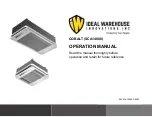
5742640-TIM-A-0419
Johnson Controls Ducted Systems
55
Manifold Gas Pressure Adjustment
Adjustments to the high-fire and low-fire (2 stage) gas flow may
be made by turning the pressure regulator adjusting screws on
the automatic gas valve.
Adjust as follows:
1.
Remove the adjustment screw cap(s) on the regulator.
2.
To decrease the gas pressure, turn the adjusting screw
counterclockwise.
3.
To increase the gas pressure, turn the adjusting screw
clockwise.
4.
Replace adjustment screw caps.
NOTE:
The factory set high-fire manifold pressure for these
furnaces is 3.50 IWG. The actual manifold pressure
depends on the local fuel heating value.
Figure 25: Proper Flame Adjustment
Pilot Checkout
The pilot flame should envelope the end of the flame sensor. To
adjust pilot flame, (1) remove pilot adjustment cover screw, (2)
increase or decrease the clearance for air to the desired level,
(3) be sure to replace cover screw after adjustment to prevent
possible gas leakage.
Put the system into operation and observe through complete
cycle to be sure all controls function properly.
Burner Instructions
To check or change burners, pilot or orifices, CLOSE MAIN
MANUAL SHUT-OFF VALVE AND SHUT OFF ALL ELECTRIC
POWER TO THE UNIT.
1.
Remove the screws holding either end of the manifold to
the burner supports.
2.
Open the union fitting in the gas supply line just upstream
of the unit gas valve and downstream from the main
manual shut-off valve.
3.
Remove the gas piping closure panel.
4.
Disconnect wiring to the gas valves and spark ignitors.
Remove the manifold-burner gas valve assembly by lifting
up and pulling back.
Figure 26: Typical Flame Appearance
Burners are now accessible for service.
Reverse the above procedure to replace the assemblies. Make
sure that burners are level and seat at the rear of the heat
exchanger.
Burner Air Shutter Adjustment
Adjust burner shutters so no yellow flame is observed in the
heat exchanger tubes.
Checking Gas Input
Natural Gas
1.
Turn off all other gas appliances connected to the gas meter.
2.
With the furnace turned on, measure the time needed for
one revolution of the hand on the smallest dial on the
meter. A typical gas meter usually has a 1/2 or a 1 cubic
foot test dial.
3.
Using the number of seconds for each revolution and the
size of the test dial increment, find the cubic feet of gas
consumed per hour from the Gas Rate - Cubic Feet Per
Hour (Table 26).
If the actual input is not within 5% of the furnace rating (with
allowance being made for the permissible range of the regulator
setting), replace the orifice spuds with spuds of the proper size.
NOTE:
To find the Btu input, multiply the number of cubic feet
of gas consumed per hour by the Btu content of the gas
in your particular locality (contact your gas company for
this information - it varies widely from city to city.)
Burner assembly bracket
Flame sensor bulb
1/8” gap between carry-over
tube and flame sensor bulb
Carry-over tube
Gas Supply Pipe
Pilot Tube
Burner Flame
(Blue Only)
Heat Tube
Exchanger
Burner
Adjustable Shutter
















































